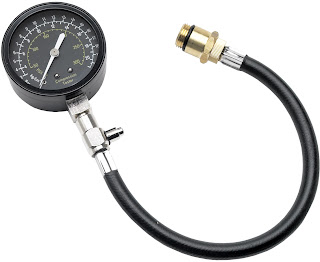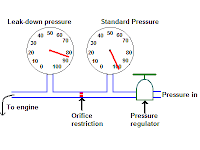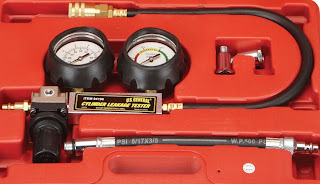Compression and Leak down Tests
Compression tests and leakdown tests provide a good indication of the general condition of an engine’s piston, rings, and cylinder area.
Compression Test
Compression tests are done on both two-stroke and four-stroke engines. To do a compression test, remove the spark plugs. Then, using the compression gauge measure the compression of each cylinder while the engine is being rotated rapidly by the electric starter or the kick or pull starter mechanism. This test ensures that the engine compression is high enough to heat the fuel and air mixture to a combustible level. The compression reading will normally exceed 125 psi. If the compression is below 125 psi, it indicates possible worn parts, and more than an engine tune-up might be needed.
 |
| COMPRESSION TEST |
Unfortunately, the results of a compression test can be deceiving. For example, if the engine isn’t in stock condition, if the battery doesn’t turn the engine fast enough, or if the testing procedures aren’t correctly followed, the compression test may indicate that the engine should be disassembled and rebuilt, when the engine is actually in good working condition. Always remember to hold the throttle control in the wide-open position when checking engine compression, to allow the maximum amount of air to be drawn into the engine. If the throttle isn’t held open, the compression reading will almost always read too low.
When the compression test has been performed correctly, there are other items you’ll need to consider. If the compression readings are all below the service limit, but the readings for all cylinders are relatively close and the engine isn’t smoking and is running okay, the compression test by itself is seldom a good reason to disassemble the engine and do an expensive engine rebuild. If the compression readings for the cylinders of a multicylinder engine vary more than 15 percent, there’s a good possibility that the engine has a problem that will need extensive repair work.
Leak down Test
Leak down tests are performed on four-stroke motorcycle and ATV engines. A leak down tester consists of a calibrated pressure gauge that’s connected to a pressure regulator, a pressure source, and a flow restrictor. As a general rule, a leak down test provides a better indication of any internal engine problems than a compression test. The test is done by pressurizing the cylinder when the piston is at top-dead-center (TDC) on the compression stroke, and measuring the rate at which the air escapes past the rings, piston, and valves.
 |
| COMPRESSION TEST |
 |
| Leak down Test |
A range of acceptable air loss percentages is given by each tester manufacturer. A leak down tester indicates when an engine probably needs repair. It also tells you where the problem is located. By listening for escaping air at the air box, the exhaust system, and engine crankcase filler-cap, you can determine if the problem is being caused by the intake valves, exhaust valves, or the piston and rings. Leak down testers are available at most quality automotive tool suppliers.
 |
| Leak down Test |
No comments:
Post a Comment